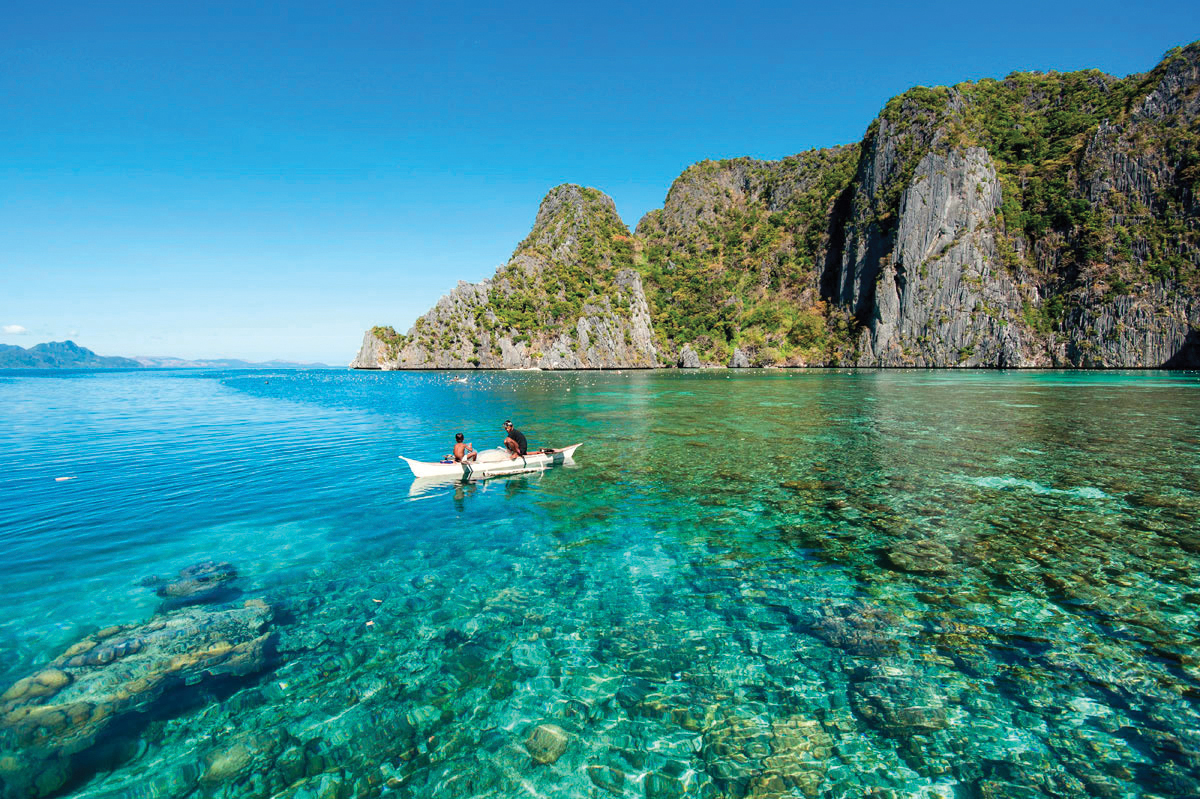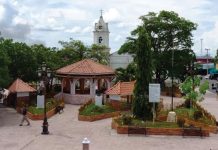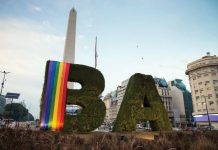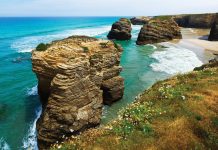Situado en el corazón del mar Caribe, la cadena de la isla de San Vicente y las Granadinas está conformada por 32 islas y cayos. Las islas relativamente desiertas ofrecen a los viajeros una combinación de aventuras de la selva, deportes acuáticos, alojamiento de lujo y kilometros de playas de arena blanca de polvo. De las 115 actividades ofrecidas a los viajeros, 59 de ellos son impresionantes sitios naturales o parques. La cadena de la isla tiene una puntuación de moderada densidad de playa de 0.22.
Cristóbal Colón bautizó la isla principal como San Vicente porque desembarcó en ella el día de San Vicente, el 22 de enero de 1498. El nombre de las Granadinas hace referencia a la ciudad española de Granada, pero para diferenciarse de la isla del mismo nombre, se utilizó el diminutivo. Antes de la llegada de los españoles, los aborígenes caribes que habitaron la isla de San Vicente la llamaban Youloumain, en honor al Youlouca, el espíritu de los arcoíris, que creían que habitaba la isla.
Los aborígenes caribes impidieron agresivamente a golpes la conquista europea en San Vicente de las Granadinas hasta el siglo XVIII. Los africanos esclavizados (tanto naufragados o como huidos de Barbados, Santa Lucía y Granada) buscaron refugio en San Vicente o Hairouna (como era llamada originalmente por los caribeños), y se mezclaron con los caribeños autóctonos, cuya descendencia mestiza se conoce como garífunas o caribes negros. A partir de 1719, los colonos franceses cultivaron café, tabaco, añil, algodón y azúcar en plantaciones trabajadas por africanos esclavizados. En 1763, San Vicente fue cedida a Gran Bretaña. Restaurado el gobierno de los franceses en 1779, San Vicente fue recuperada por los británicos bajo el Tratado de París (1783), en el cual Gran Bretaña reconocía oficialmente el la independencia de los Estados Unidos. Tratados complementarios se firmaron también con Francia y España, conocidos como los Tratados de Versalles de 1783, parte de los cuales volvieron a poner a San Vicente bajo control británico.
El conflicto entre los británicos y los caribes negros, liderados por el desafiante Jefe Supremo Joseph Chatoyer, continuó hasta 1796, cuando el general Sir Ralph Abercromby aplastó una revuelta fomentada por el radical francés Victor Hughes. Más de 5000 caribes negros fueron finalmente deportados a Roatán, una isla frente a la costa de Honduras.
Las islas que conforman San Vicente y las Granadinas nacen en el mar Caribe y forman parte de las Islas de Sotavento. Se ubican al oeste de Barbados, al sur de Santa Lucía y al norte de Granada. El territorio de San Vicente y las Granadinas consta de 32 islas e islotes: la isla principal, San Vicente (344 km²)1 y los dos tercios septentrionales de las Granadinas (45 km²). Las Granadinas son una cadena de islas pequeñas que se encuentran al sur de San Vicente y al norte de Granada, a quien pertenece el tercio meridional del grupo.
El terreno es en su mayor parte montañoso y el suelo es de origen volcánico. El punto más alto del país es el volcán La Soufrière, con 1234 msnm. El clima es tropical, con poca variación de la temperatura en el curso del año. La estación de lluvias abarca de mayo a noviembre. La economía sanvicentina es muy modesta y su principal fuente de ingresos es la exportación de plátanos y algunos productos agrícolas, así como la emisión de sellos postales destinados principalmente al coleccionismo filatélico mundial. Aunque el turismo ha venido creciendo en los últimos años, el gobierno no ha podido diversificar su fuente de divisas. Una gran parte de los productos que consumen tiene que ser importada de sus socios comerciales. La emisión de sellos postales, principalmente destinado al coleccionismo filatélico, es también una importante fuente de ingreso para su economía. Su moneda es el dólar del Caribe Oriental (EC$). El éxito de la economía se basa en las variaciones estacionales en la agricultura, el turismo y la actividad de la construcción, así como las entradas de remesas.
 Located in the heart of the Caribbean Sea, the chain of the island of Saint Vincent and the Grenadines is made up of 32 islands and cays. The relatively deserted islands offer travelers a combination of jungle adventures, water sports, luxury accommodation and miles of powder white sand beaches. Of the 115 activities offered to travelers, 59 of them are impressive natural sites or parks. The island chain has a moderate beach density score of 0.22.
Located in the heart of the Caribbean Sea, the chain of the island of Saint Vincent and the Grenadines is made up of 32 islands and cays. The relatively deserted islands offer travelers a combination of jungle adventures, water sports, luxury accommodation and miles of powder white sand beaches. Of the 115 activities offered to travelers, 59 of them are impressive natural sites or parks. The island chain has a moderate beach density score of 0.22.
Christopher Columbus baptized the main island as San Vicente because he landed on it on Saint Vincent’s Day, on January 22, 1498. The name of the Grenadines refers to the Spanish city of Granada, but to differentiate itself from the island of the same name, the diminutive was used. Before the arrival of the Spaniards, the Caribbean aborigines who inhabited the island of San Vicente called it Youloumain, in honor of Youlouca, the spirit of the rainbows, which they believed inhabited the island.
The Caribbean aborigines aggressively prevented the European conquest in Saint Vincent of the Grenadines until the 18th century. The enslaved Africans (both shipwrecked or escaped from Barbados, Santa Lucia and Granada) sought refuge in San Vicente or Hairouna (as it was originally called by the Caribbeans), and mixed with native Caribbeans, whose mestizo offspring are known as Garífuna or Black Caribs. Beginning in 1719, French settlers grew coffee, tobacco, indigo, cotton and sugar in plantations worked by enslaved Africans. In 1763, San Vicente was ceded to Great Britain. Restored the government of the French in 1779, San Vicente was recovered by the British under the Treaty of Paris (1783), in which Great Britain officially recognized the independence of the United States. Complementary treaties were also signed with France and Spain, known as the Versailles Treaties of 1783, part of which put St. Vincent back under British control.
The conflict between the British and the Black Caribs, led by the defiant Chief of Staff Joseph Chatoyer, continued until 1796, when General Sir Ralph Abercromby crushed a revolt fomented by the French radical Victor Hughes. More than 5000 black Caribs were finally deported to Roatán, an island off the coast of Honduras.
The islands that make up Saint Vincent and the Grenadines are born in the Caribbean Sea and are part of the Leeward Islands. They are located west of Barbados, south of Santa Lucia and north of Granada. The territory of Saint Vincent and the Grenadines consists of 32 islands and islets: the main island, Saint Vincent (344 km²) 1 and the northern two thirds of the Grenadines (45 km²). The Grenadines are a chain of small islands that lie south of San Vicente and north of Granada, to which the southern third of the group belongs.
The terrain is mostly mountainous and the ground is of volcanic origin. The highest point of the country is the La Soufrière volcano, with 1234 masl. The climate is tropical, with little variation in temperature during the year. The rainy season covers from May to November. Sanvicentina’s economy is very modest and its main source of income is the export of bananas and some agricultural products, as well as the issuance of postage stamps destined mainly to the philatelic collection worldwide. Although tourism has been growing in recent years, the government has not been able to diversify its source of foreign currency. A large part of the products they consume have to be imported from their business partners. The issuance of postage stamps, mainly destined for philatelic collecting, is also an important source of income for its economy. Its currency is the Eastern Caribbean dollar (EC $). The success of the economy is based on seasonal variations in agriculture, tourism and construction activity, as well as the inflow of remittances.















